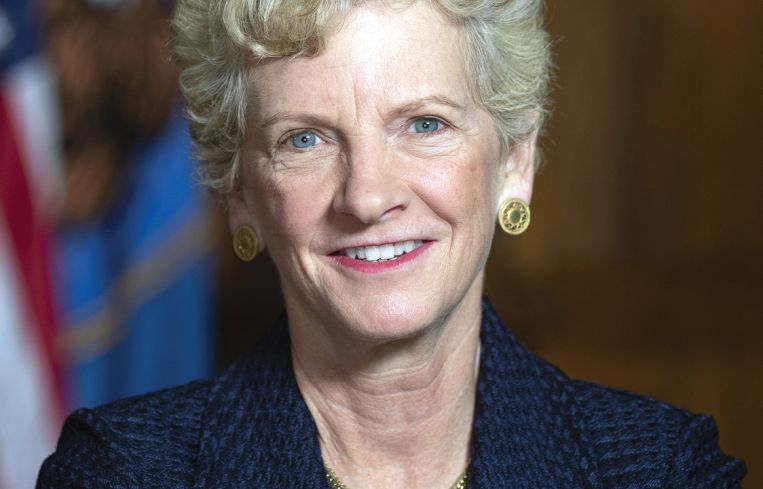GSA Administrator Robin Carnahan: Sustainability Will Help Guide Billions in Investments
Thousands of leases with federal agencies are expiring in the next few years
By Keith Loria September 28, 2023 4:30 pm
reprints
The U.S. General Services Administration — the federal government’s real estate manager — is going to use environmental sustainability as a major benchmark for its projects. That’s according to Robin Carnahan, the agency’s administrator.
The Government Accountability Office earlier this year reported that more than half of all federal leases — 4,108 out of 7,685, accounting for more than 83 million square feet —are going to expire in the next five years. As new leases are sought, they will include GSA’s updated green leasing guidelines and established preferences for leases with enhanced sustainable performance.
“As we think about rightsizing and optimizing the federal portfolio, we need to think about our leased buildings as well as which buildings we keep in our federal inventory that are owned buildings and which ones we dispose of,” Carnahan told Commercial Observer on Thursday. “All of this is really driven by our agency partners and customers and what their needs are. And it’s no secret, everybody’s sort of rethinking what the basic needs are.”
A number of these leases may be downsized as well, as federal workers, much like a lot of the American workforce, have not fully returned to the office since the pandemic. GSA is working closely with agencies across the federal government about what their plans are for in-office operations as well as other kinds of hybrid work
“I think it’s going to look different by agency, because each agency’s missions are a little different, but we’re going to figure out how to serve them, whatever their requirements are,” Carnahan said. “It’s not all driven by sustainability, but when we are making these investments, we want to make sure they’re the ones that make sense for us to hold long term in our portfolio because they serve our agency needs. And those are the ones that we’re making sustainable investments in.”
Meanwhile, the GSA is pushing sustainability in this and other longer-term decisions.
“We are really a leader in all this, in part because we’ve been doing it a long time, but also we got about $3.4 billion in the Inflation Reduction Act to work on that,” Carnahan said.
That money falls into three primary buckets. About $2 billion is focused on low embodied carbon building materials, just under $1 billion is aimed at innovative new products that create efficiencies that will be tested out in federal buildings, and approximately $250 million to be used for high-performance green buildings.
For instance, in Denver, where the GSA has the largest group of civilian federal employees outside of D.C., $88 million was earmarked last month to make 18 federal buildings more sustainable. This includes installing high-efficiency ground-source heat pumps, adding solar panels, and upgrading heating and cooling systems.
In Cleveland, the GSA is investing $9 million toward energy and cost-saving upgrades at the Carl B. Stokes Federal Courthouse Building, which will involve converting it into an all-electric building in which none of the equipment will use on-site fossil fuel combustion. To accomplish this, gas-fired heaters will be replaced with electric units, and the existing electric boilers and electric chillers will be replaced with new, more efficient, state-of-the-art electric chillers and boilers. Additionally, fluorescent light fixtures will be replaced with LED light fixtures.
In Washington, D.C., the GSA will convert the Ronald Reagan Building and International Trade Center to an all-electric building. Altogether, more than 100 more buildings across the U.S. will be transformed, including 28 that will be fully net zero.
“Some of it will be on-site generated, but others are changing out the equipment so it can take electricity off the grid,” Carnahan said. “Another thing we are focused on in a lot of markets is carbon-free electricity.”
An example of that is in Arkansas. GSA recently entered into an agreement with Entergy Arkansas, which is the main power provider in the state, to buy carbon-free power off the grid for the federal facilities.
“It’s the first in the country where we have a green tariff that we are able to work with the utility to get passed through the state Public Service Commission,” Carnahan said. “This really is something where the government’s ability to do some of these things is helping catalyze markets that private sector companies want to have access to as well.”
Also in D.C., Carnahan spent some time this week at the historic former hospital campus known as St. Elizabeth’s looking at the Department of Homeland Security’s headquarters there.
“There are several new buildings going up there, with two new headquarters going to be moved there — one for CISA (Cybersecurity and Infrastructure Security Agency) and the other for ICE (U.S. Immigration and Customs Enforcement), and those are going to be using low-embodied carbon building materials and meet the highest sustainability standards.”
Carnahan spent this week at Greenbuild 2023, the U.S. Green Building Council’s government summit, and says she felt a real buzz and excitement about sustainability.
“The president talks all the time about where is it written that we can’t manufacture things in the United States again, and that’s right, we can decide that’s going to be a thing we care about,” she said. “So, when we’re making these sustainability investments, I think of them as a triple win. First, they are good for local, domestic jobs in the U.S.; second, they are great for saving money, because when you reduce energy costs, it saves money for taxpayers; and third is it’s better for our planet and the future for our kids.”
Keith Loria can be reached at Kloria@commercialobserver.com.


